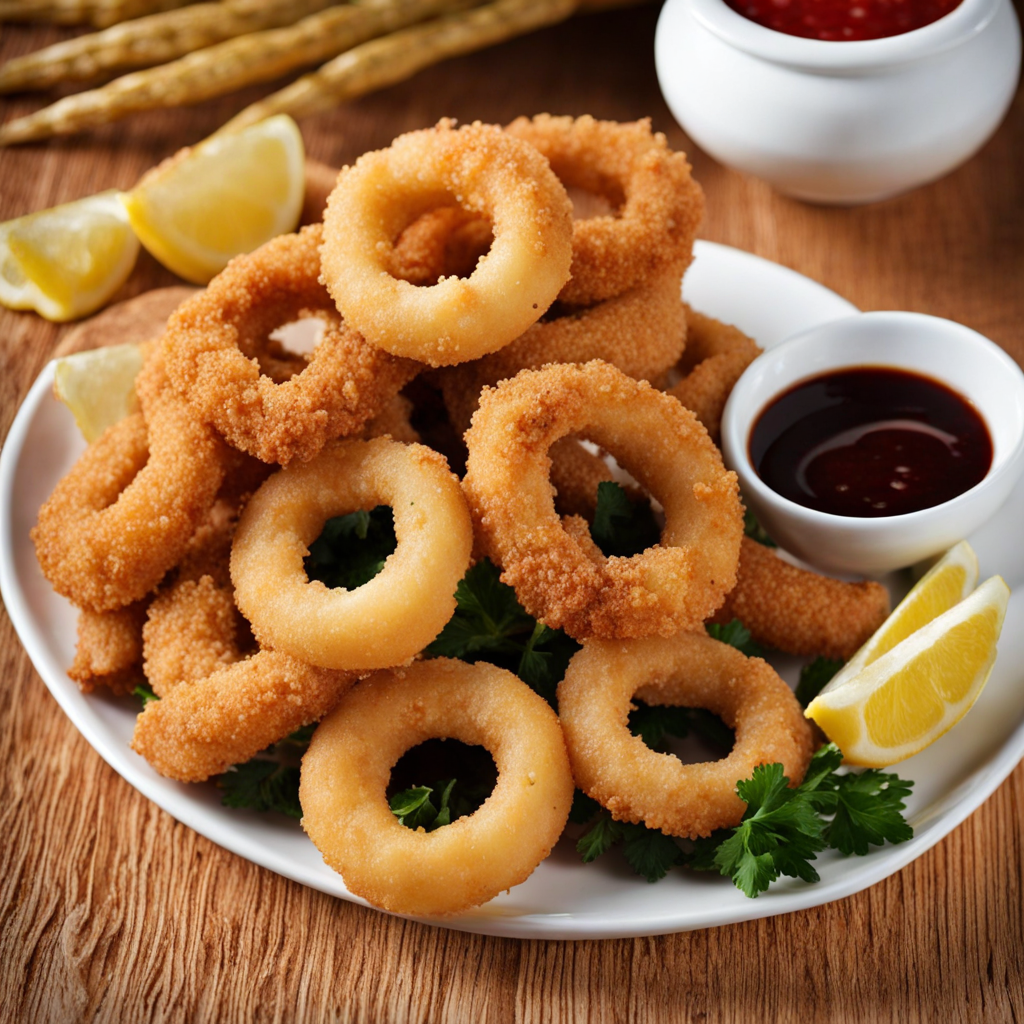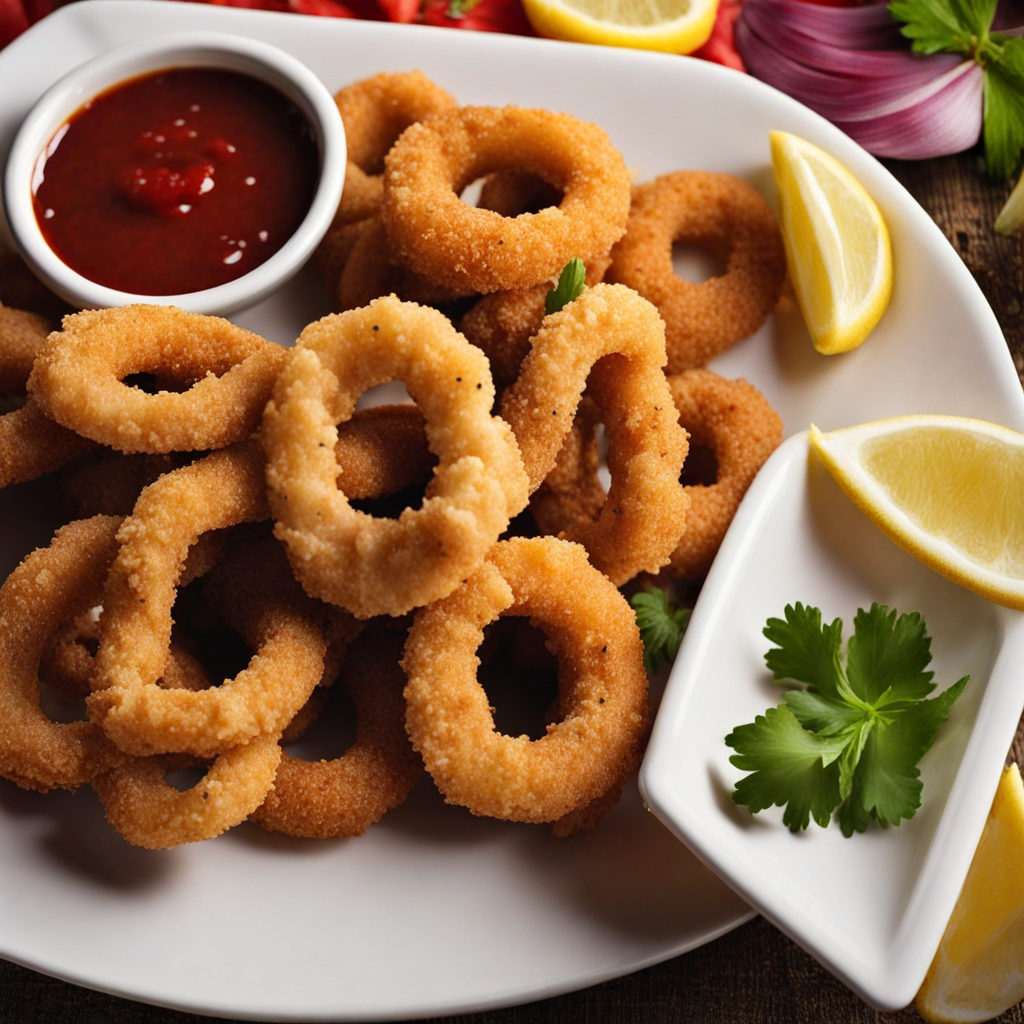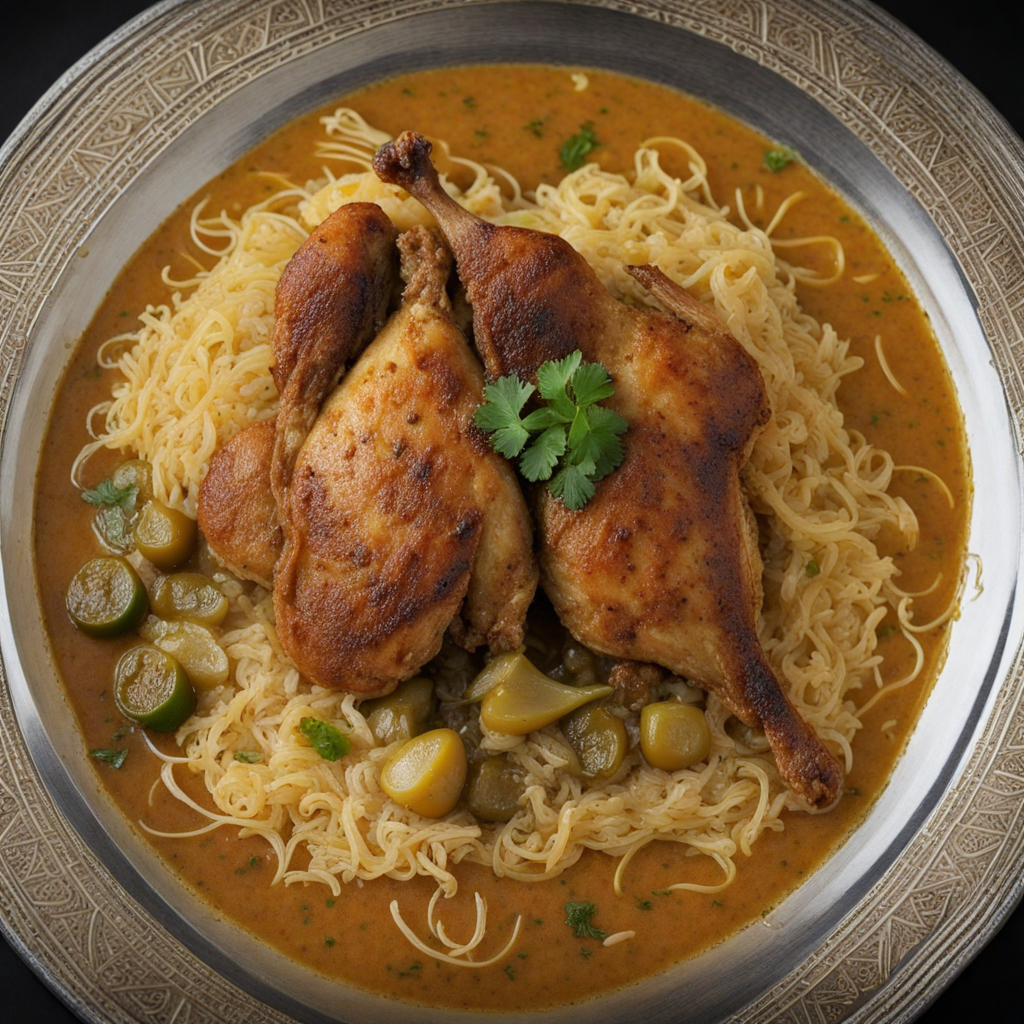Calamari Rings
Calamari Rings, a delightful seafood dish hailing from the vibrant coastal regions of Morocco, offer a unique twist on a classic favorite. These tender rings are made from fresh squid, expertly cleaned and sliced into perfect circles, showcasing their delicate texture. The Moroccan take on calamari often features a harmonious blend of spices, including cumin, paprika, and coriander, which infuse the dish with a warm, aromatic flavor profile that reflects the country's rich culinary heritage. To prepare Calamari Rings, the squid is typically marinated in a mixture of lemon juice and spices, allowing the flavors to penetrate the meat before it is lightly coated in flour or breadcrumbs. This technique not only adds a satisfying crunch when fried but also ensures that the calamari maintains its succulent nature. Served hot and golden brown, these rings are often accompanied by a tangy dipping sauce, such as a harissa-infused aioli or a zesty garlic-lemon dressing, enhancing the overall experience with a burst of freshness. As you take your first bite of Moroccan Calamari Rings, you'll be greeted with a delightful crunch followed by a tender, flavorful center, making each mouthful a celebration of taste and texture. The spices meld beautifully with the natural sweetness of the squid, creating a dish that is both comforting and exotic. Perfect as an appetizer or as part of a larger seafood feast, Calamari Rings embody the essence of Moroccan cuisine, inviting you to explore a world of flavors that dance on your palate.
How It Became This Dish
The History of حلقات الكالاماري (Calamari Rings) in Morocco Origins of Calamari: The term ‘calamari’ is derived from the Italian word for squid, which reflects its Mediterranean roots. While the dish is most commonly associated with Italian cuisine, squid has been a staple in many coastal cultures around the world, particularly around the Mediterranean Sea. In Morocco, the consumption of squid and other seafood can be traced back to the country’s long history of trade and cultural exchange along the Atlantic and Mediterranean coasts. Morocco's geographical position, bridging Europe and Africa, facilitated not only trade but also culinary exchanges. The rich waters off Morocco’s coast are home to a diverse array of seafood, including the beloved squid. The practice of frying squid into rings came about as culinary techniques evolved, influenced by the many cultures that have made their mark on Moroccan cuisine, including the Berbers, Arabs, and Europeans. Cultural Significance: In Moroccan culture, food is not just sustenance; it is a means of bringing people together. Traditional meals are often communal, emphasizing the importance of family and social bonds. The preparation and sharing of food is seen as a way to honor guests and celebrate special occasions. حلقات الكالاماري, or calamari rings, have become a popular choice in Moroccan households and restaurants, especially in coastal cities like Essaouira and Agadir, where fresh seafood is readily available. The dish embodies the Moroccan spirit of hospitality and communal dining, often served with a variety of dipping sauces or alongside a fresh salad. As Moroccan cuisine evolved, so did the ways in which calamari was prepared and served. While traditional methods included grilling or stewing squid with spices and herbs, the introduction of frying calamari rings became a favored technique, particularly with the influence of European culinary practices. Development Over Time: The development of حلقات الكالاماري in Morocco reflects broader trends in culinary practices. In the early 20th century, as Morocco began to modernize and open up to global influences, the demand for seafood increased. Fishermen began to adopt modern techniques and equipment, allowing for a greater catch of squid. The rise of tourism also brought international culinary influences to Moroccan shores, with restaurants beginning to feature calamari on their menus to cater to European tastes. The adaptation of calamari rings in Moroccan cuisine can be attributed to several factors: the availability of fresh squid, the influence of Mediterranean culinary traditions, and the Moroccan knack for incorporating spices and flavors into every dish. Spices such as cumin, paprika, and coriander, combined with garlic and lemon, are often used to enhance the natural flavors of the squid, creating a dish that is both familiar and distinctly Moroccan. Street food culture also played a significant role in the popularization of حلقات الكالاماري. Vendors in coastal cities began to offer fried calamari rings as a quick and delicious snack, serving them hot with a sprinkle of fresh lemon juice. This made the dish accessible to a broader audience, from locals to tourists exploring the vibrant Moroccan coast. Modern Adaptations: In recent years, the popularity of حلقات الكالاماري has grown beyond traditional settings. As Moroccan cuisine gains recognition on the global stage, chefs are experimenting with calamari in innovative ways. Modern interpretations may include an array of spices, unconventional dipping sauces, and unique presentations that reflect Morocco’s rich culinary heritage while embracing contemporary trends. Gastronomic tours in Morocco now often include seafood tastings, with calamari rings featuring prominently. Many chefs and food enthusiasts are also focusing on sustainability, sourcing squid from responsible fisheries to ensure that this beloved dish can be enjoyed for generations to come. In addition, social media has played a significant role in elevating Moroccan cuisine, with food bloggers and influencers showcasing dishes like حلقات الكالاماري. The visual appeal of golden, crispy calamari rings garnished with fresh herbs and served with colorful sauces has resonated with audiences worldwide, leading to a resurgence of interest in Moroccan seafood dishes. Conclusion: The journey of حلقات الكالاماري from its origins in the Mediterranean to its embrace in Moroccan cuisine reflects a rich tapestry of history, culture, and innovation. From its early beginnings as a simple seafood dish to its current status as a beloved staple in both home kitchens and restaurants, calamari rings encapsulate the essence of Moroccan culinary traditions. The evolving preparation methods, the integration of local flavors, and the communal nature of the dish have all contributed to its significance in Moroccan culture. As the world becomes more interconnected, the story of حلقات الكالاماري serves as a reminder of how food transcends borders, bringing together diverse cultures and histories on a shared plate. In a country where food is an integral part of social life, حلقات الكالاماري stands as a delicious symbol of Morocco’s coastal abundance and its rich culinary heritage, inviting both locals and travelers to savor its flavors and share in its story.
You may like
Discover local flavors from Morocco







